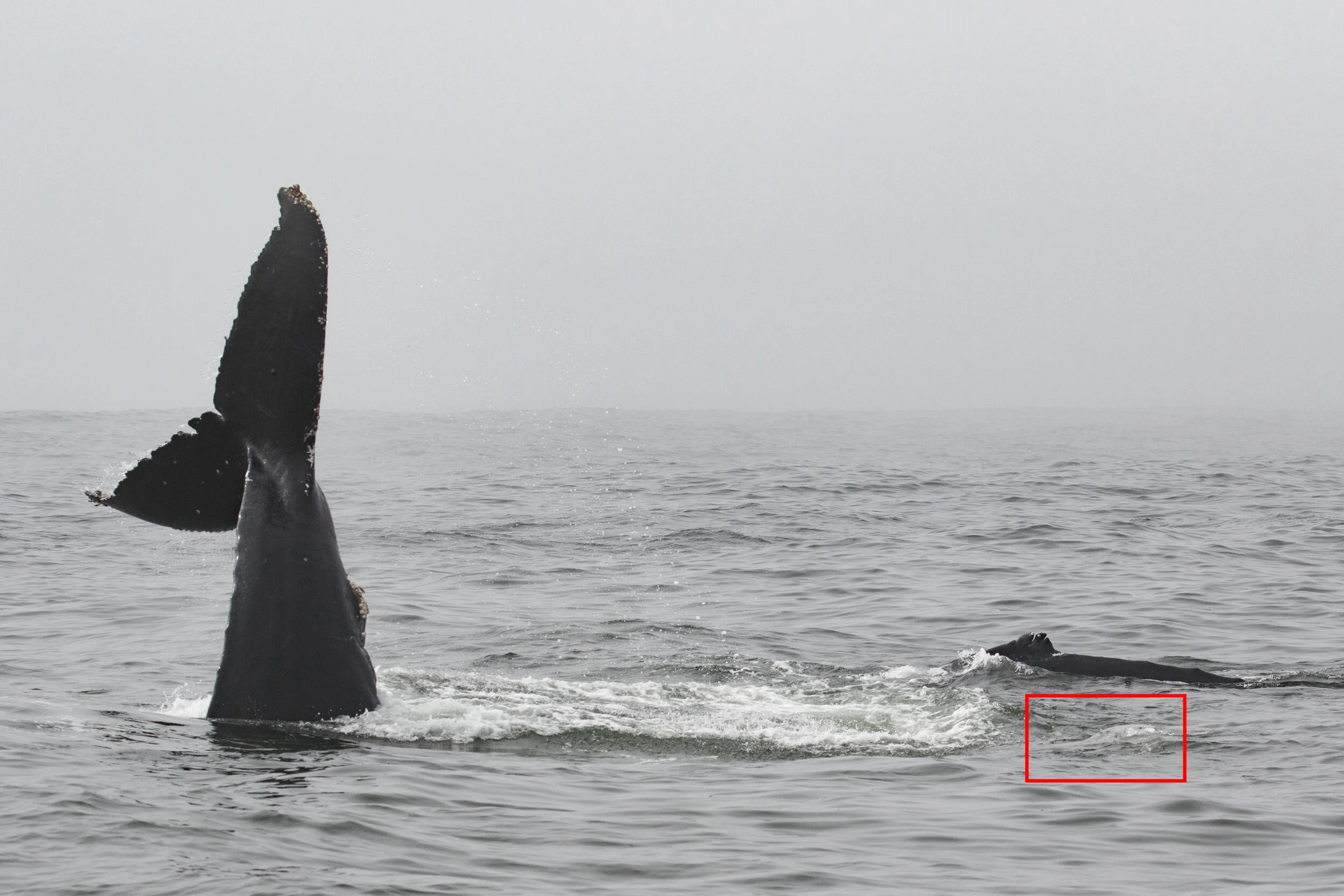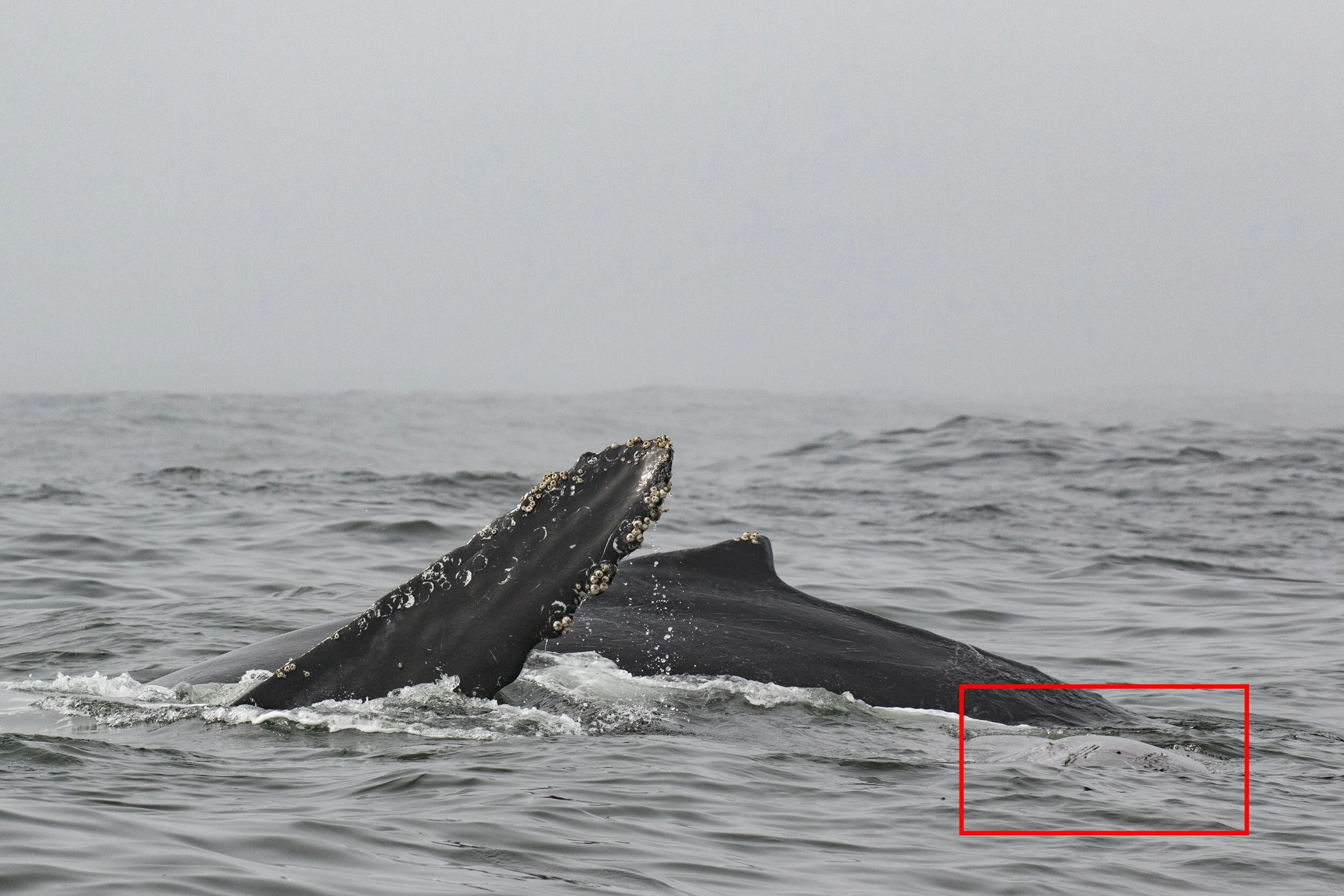Humpback Intervenes at Crime Scene, Returns Next Day with Friend
Never before witnessed: humpback whales investigate gray whale calf carcass
By Jodi Frediani, Photographer
In 2018, eyes were riveted on J35, a Southern Resident killer whale nicknamed Tahlequah. For 17 days she carried her dead calf over 1,000 miles, along the Pacific Northwest coast. She carried and sometimes pushed the carcass with her head in what became known as a ‘tour of grief’. Her poignant display of mourning captured the hearts and minds of people around the world. And her maternal care reiterated that cetaceans are capable of deep emotions.
While many scientists are reluctant to attribute emotional complexity to non-human animals (they do acknowledge that some animals experience pain), these walls of separation erected between ourselves and other species are being dismantled. This is cause for celebration. As Henry Beston reminds us, “In a world older and more complete than ours, they move finished and complete, gifted with the extension of the senses we have lost or never attained, living by voices we shall never hear. They are not brethren, they are not underlings: they are other nations, caught with ourselves in the net of life and time, fellow prisoners of the splendour and travail of the earth.”
Dolphins and orcas (which are simply enormous dolphins) live in family groups and have been observed both in captivity and in the wild exhibiting post-mortem attentiveness—that is attending to their dead, usually their own calves or other group members. But rarely have any of the large baleen whales, which tend to live more solitary lives, been seen paying attention to their deceased kin. So, do they simply not care, or have opportunities for human observation just not presented themselves?
Tahlequah’s doomed calf was born alive July 24, 2018, but died within ½ hour of birth, leading to that remarkably long period of maternal attention focused on her deceased baby. Orcas have a charisma that endears them to the general public, and 17 days gave even the most inattentive among us time to learn about the sad event.
But just 3 months prior, nearly to the day, on April 22, two humpback whales exhibited some perhaps more remarkable behavior towards a dead whale calf. In this case, however, the calf was a gray whale, killed by transient orcas the day before, and the behavior was observed for a mere 12 minutes. However brief, this was the first time such interspecies interaction among baleen whales had been observed in the wild. It was also the first time humpback whales were seen exhibiting post-mortem attentive behavior towards any calf.
Close up of the gray whale calf carcass, Day 2. Photo: Jodi Frediani
Here both humpbacks maintain close proximity to the carcass. HW-MN0500323, named “Ornament,” does a headstand, while HW-MN0500205, named “Exclaim,” makes a close pass by the carcass. Exclaim was present the day before during the feeding event. Interestingly, Ornament seemed to spend more time doing close inspections (red box indicates location of gray whale calf carcass). Photo: Jodi Frediani
This event didn’t generate the same public attention, as the optics were not nearly so compelling, and it might have remained scrawled notes on a data sheet. But the rarity of the event and the significance of the implications were recognized and published in a scientific paper in 2020.
Such papers are usually read only by practitioners within the scientific community, but it seems this story deserves a larger audience. I would like to take this opportunity to share the tale of these two whales, so we can continue to further educate ourselves about the complex emotional lives of animals.
The day before our two humpbacks checked out the calf carcass, marine biologist with the California Killer Whale Project, Nancy Black, who also owns Monterey Bay Whale Watch, spent many hours with a boat full of whale watch passengers observing a family group of killer whales feeding on the dead calf. The kill was not witnessed, but likely made earlier that morning by the feeding group. Sometime during the day, three humpback whales appeared and began to harass the killer whales. Such interference, known as mobbing behavior, has been observed on numerous occasions during killer whale hunts. But here the orcas had completed the hunt and had commenced feeding on the carcass.
What makes this particularly remarkable is that one of those humpbacks returned the next day with a companion, and the two spent 12 minutes exploring the carcass, using their heads, their sides, their bellies, their flippers and flukes to touch or reach out to the carcass. They were clearly excited as they gave noisy exhalations called wheezed blows. One slashed its flukes. They did head stands and spy hops, rolled and generally focused all their attention on the deceased gray whale calf, before finally swimming away.*
“Ornament” the humpback whale touches the carcass with his chest. Photo: Jodi Frediani
Ornament does a strange rotation of the left pectoral flipper, while next to the gray whale calf carcass. Photo: Jodi Frediani
Nancy Black had made a point of returning to the scene that morning as orcas are known to feed on a carcass for up to two days following a kill. But she got more than she bargained for. As we arrived, we could just make out a couple of killer whales in the fog, though moments later they headed north. But that was not all. Two humpbacks surfaced next to the floating carcass. "I decided to leave the killer whales as they swam away and instead focus on this interaction with the humpbacks,” said Black. “I immediately recognized the unique behavioral event that was occurring between the humpbacks and the dead gray calf as something I had never witnessed." Those of us on board were extremely fortunate to have front row seats to this unique, never-before-seen behavior.
Two killer whales from the previous day’s feeding group hanging out near the carcass on Day 2. They left shortly after we arrived.
What were those humpbacks thinking? Were they learning more about the predatory ‘killers of whales’ that sometimes attack their own calves? Were they just curious, playing, or can we call their interest morbid fascination? Perhaps they were grieving. For now, we cannot say. Perhaps some day, we’ll crack the code of communication and be able to understand the motives behind the animal behaviors we are fortunate to witness.
Two humpback whales ‘mobbing’ the killer whales the day before. Photo: Jodi Frediani
In the meantime, we’ll add this encounter to the broad range of remarkable behaviors of humpback whales. They catch fish by blowing great bubble nets, they inexplicably fly out of the sea in full body breaches, and they use their long pectoral flippers and tails to slap the water, likely communicating with others in the vicinity. They play with seaweed, bubbles and dolphins, and their song has mesmerized ancient sailors along with modern-day whale enthusiasts. Those melodic song lines are even wending their way into interstellar space on a gold-plated record aboard the Voyager spacecraft. Humpback song was included along with fifty-five languages of human — ‘Earth people’ — greetings to aliens who might find the disk some day. Not only do humpback whales sing, play, and make and use tools, but they have taken on the role of non-human ambassadors of life on Planet Earth.
* We were able to confirm it was the same whale from photos of the distinctive scarring on its dorsal fin. Later, using fluke ID photos submitted to Happywhale, a citizen science- based ID project, we managed to get identification of the two humpbacks and learn a bit about their travels. We believe that both are male, based on their activities on the breeding grounds off Mexico.






